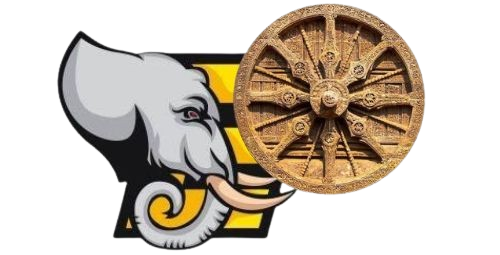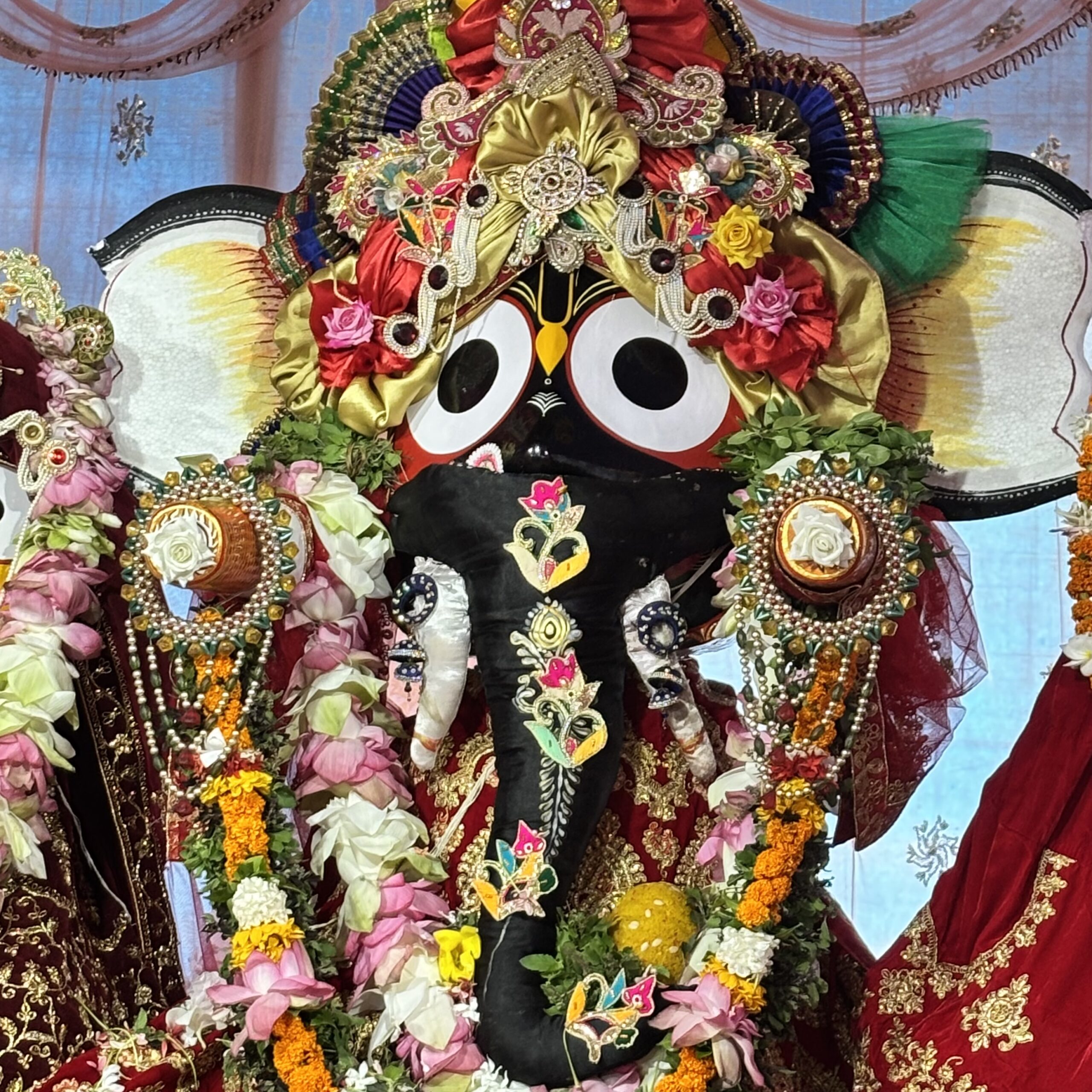The sacred traditions of Lord Jagannath, the presiding deity of Puri in Odisha, are adorned with layers of deep symbolism, vibrant rituals, and timeless devotion. Among the many ceremonial adornments (known as Besha) that the Lord dons throughout the year, one of the most awe-inspiring and spiritually significant is the Gajanana Besha, popularly known as Hati Besha—the Elephant Attire.
Celebrated with grandeur and unmatched devotion on the occasion of Snana Purnima, the Gajanana Besha stands as a visual and philosophical confluence of Jagannath’s identity as Vishnu, Krishna, and Ganesha, reflecting the inclusiveness of the Jagannath cult that transcends sectarian divides.
This article presents a detailed exploration of Lord Jagannath’s Hati Besha, including its origin, spiritual meaning, ritualistic details, and cultural significance.
What is Hati Besha or Gajanana Besha?
Hati Besha, also called Gajanana Besha, literally translates to the “Elephant Attire” of Lord Jagannath. It refers to a sacred ritual in which Lord Jagannath, Balabhadra, and Subhadra are decorated to resemble Lord Ganesha, the elephant-headed god of wisdom, prosperity, and remover of obstacles.
This rare and revered attire is performed only once a year, on Snana Purnima, the full moon day in the month of Jyestha (May–June). On this day, the deities are brought out of the sanctum sanctorum to the Snana Mandapa (bathing platform) and are ceremonially bathed with 108 pots of sacred water. Following the bathing ritual, they are dressed in the Hati Besha, drawing lakhs of devotees from across India and abroad.
Origins and Mythological Significance of Gajanana Besha
The origin of Hati Besha is both mythological and ritualistic, blending elements of tribal customs, Shaivite influence, and Vaishnavite theology.
1. Tribal and Tantric Influences
Before the Jagannath cult took its classical Vaishnavite shape, it had strong tribal roots, particularly among the Sabara community. In many tribal traditions, elephants are sacred animals symbolizing strength, wisdom, and royal authority. It is believed that the practice of decorating the deity in the form of an elephant evolved from these indigenous practices, where deities were adorned in the forms of powerful animals to evoke protection and benevolence.
2. Connection with Lord Ganesha
The elephant form is unmistakably associated with Lord Ganesha, son of Lord Shiva and Parvati, who is worshipped at the start of all auspicious occasions in Hinduism. According to one legend, Lord Jagannath took the form of Gajanana to honor and please Lord Ganesha, acknowledging Him as the first deity to be venerated. This form also highlights the inclusive nature of Jagannath, who embodies multiple divine aspects.
3. Purification and Rebirth Theme
After the Snana Yatra, Lord Jagannath and His siblings are believed to fall ill due to the excessive bathing and are kept away from public view in a secret chamber (Anasara Ghara) for 15 days. The Hati Besha is considered a transitional state, symbolizing the divine transformation and cleansing before the deities retreat for rejuvenation. The elephant form is seen as a divine disguise taken to rest from the world’s gaze.
Rituals and Details of the Hati Besha Celebration
1. Snana Purnima and Public Darshan
The ritual begins with the Snana Yatra, when the deities are brought in a grand procession from the Garbha Griha (sanctum) to the Snana Mandapa, a specially designed bathing altar on the temple premises. This is one of the few days in the year when devotees get a close view (Sahana Mela) of the deities outside the inner sanctum.
The deities are bathed with 108 pots of water collected from the Suna Kua (Golden Well) within the temple. The water is sanctified with Vedic mantras, herbs, and flowers. This grand ritual symbolizes the purification of the deities and by extension, the devotional cleansing of all beings.
2. Adorning the Elephant Form
After the bathing ritual, the Daitapatis (a specific group of temple servitors from tribal lineages) dress the deities in the Hati Besha. The process includes:
- Elephant Headgear: Large, beautifully crafted elephant masks made of wood, paper, bamboo, and cloth are fixed on the faces of Lord Jagannath and Lord Balabhadra.
- Subhadra’s Decoration: Devi Subhadra is adorned with flower garlands and ornaments but does not wear the elephant headgear.
- Costumes and Ornaments: Rich silken cloth, jewelry, and vibrant floral decorations complete the divine ensemble.
The color scheme for Hati Besha is significant:
- Lord Jagannath’s elephant head is colored black, representing the cosmic form and Krishna’s dark complexion.
- Lord Balabhadra’s is white, symbolizing purity and clarity.
This visual spectacle is considered highly auspicious, with pilgrims believing that witnessing Hati Besha grants freedom from obstacles and brings prosperity.
Philosophical and Spiritual Interpretations
1. The Universality of Divinity
By adopting the form of Gajanana, Lord Jagannath demonstrates that divinity cannot be confined to a single form or sect. He is Vishnu, Krishna, Shiva, and Ganesha—all in one. This concept aligns with the non-sectarian vision of Jagannath culture, which embraces diversity and unity.
2. The Embodiment of Compassion
Elephants are symbols of gentleness, patience, and immense strength. Through the Hati Besha, Lord Jagannath reflects the divine qualities of compassionate strength, teaching that power must be wielded with humility and benevolence.
3. Symbol of Inner Awakening
The elephant head also symbolizes intellect and spiritual awakening, both central themes in Ganesha’s worship. Jagannath, in this form, urges devotees to overcome inner ignorance and embark on a path of knowledge, devotion, and surrender.
Cultural Impact and Legacy
The Gajanana Besha of Lord Jagannath is not just a religious ritual but a cultural phenomenon that resonates across generations and geographies.
1. Artistic Heritage
The creation of the Hati Besha headgear and decorations showcases the artistic brilliance of Puri’s craftsmen. Local artisans pass down the skills required to make these intricate pieces through oral traditions and apprenticeships.
2. Symbol in Popular Art and Music
The imagery of Hati Besha has found its way into Odissi dance, folk music, temple murals, and even contemporary spiritual discourses. Songs praising Lord Jagannath in His Gajanana form are sung with deep emotion and cultural pride.
3. Inclusiveness in Practice
People from all castes, communities, and even different faiths gather during Snana Purnima to witness this divine transformation. It reflects Jagannath’s core philosophy—Sarva Dharma Samabhava (respect for all religions).
Conclusion
The Gajanana Besha or Hati Besha of Lord Jagannath is a radiant expression of spiritual plurality, divine compassion, and ritual magnificence. Rooted in tribal traditions and enriched by scriptural symbolism, it exemplifies how the Jagannath cult beautifully synthesizes the essence of various deities and philosophical paths.
More than a visual delight, Hati Besha is a soul-stirring reminder of the eternal truth that God appears in many forms to guide devotees on the path of righteousness. As the rhythmic chants of “Jai Jagannath!” rise under the full moon of Snana Purnima, Lord Jagannath, in His elephantine glory, silently assures the world—He is One, yet many; visible, yet eternal.


